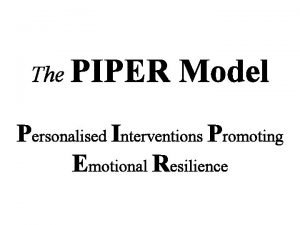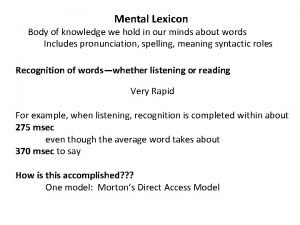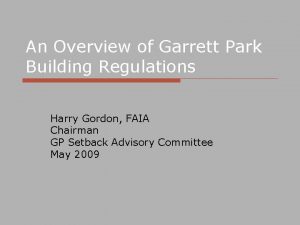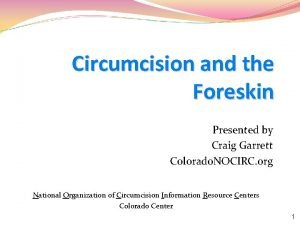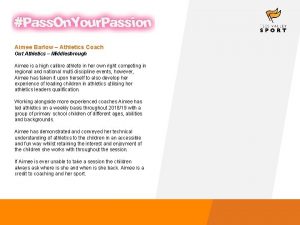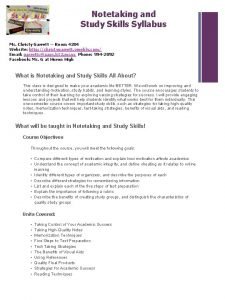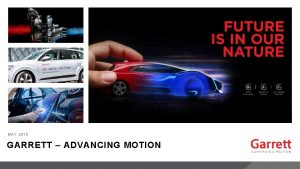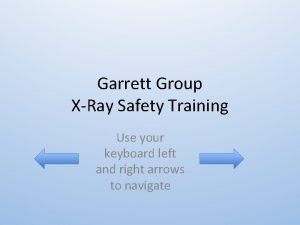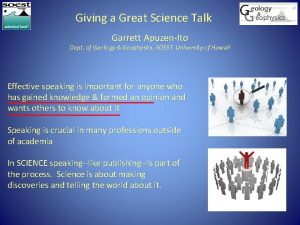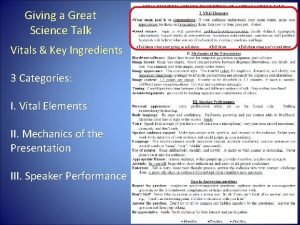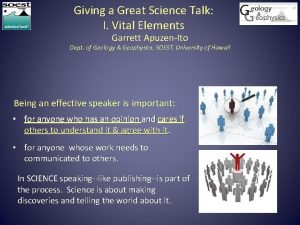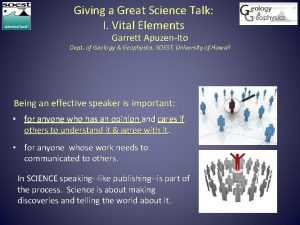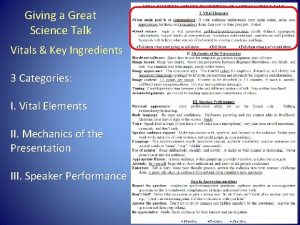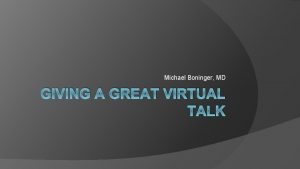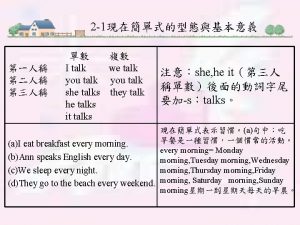Giving a Great Science Talk Garrett ApuzenIto Dept

















































- Slides: 49

Giving a Great Science Talk Garrett Apuzen-Ito Dept. of Geology & Geophysics, SOEST, University of Hawaii Effective speaking is important for anyone who has gained knowledge & formed an opinion and wants others to know about it Speaking is crucial in many professions outside of academia In SCIENCE speaking--like publishing--is part of the process. Science is about making discoveries and telling the world about it.

Giving a Great Science Talk I. Vital Elements II. Mechanics of the Presentation III. Speaker Performance

I. Vitals Elements

I. Vitals Elements FIRST AND FOREMOST: Your purpose is to… Communicate, Convince, and Teach WMDs! audience walks away understanding It. Ifisyour essential that YOU know your main points, gains new appreciation for points. You should have 1 -3 main (or is convinced of) them, and remembers points noyour more them, then you’veand done job. . No matter how you do it (almost). Now here’s the main point

How Many Points Should You Make?


Elements of a formal science talk: I. Motivate & Introduce the Scientific Questions, Problem, or Hypothesis, and Outline Your talk II. Strategy, Methods &/or Data III. Results and Interpretations IV. Conclusions } Tell ‘em what your gonna tell ‘em } Tell them. } Tell ‘em what you told ‘em

This format represents a system of logical reasoning. An underlying thread along which your story progresses. I. Motivate & Introduce Science Questions, Problem, or Hypothesis & Outline Talk } II. Strategy/Methods/Data III. Results/Interpretations IV. Conclusions

More generally … a “science-related” talk is organized as: I. Motivate and Introduce the Topic/Goal II. Define Strategy and Concepts III. Explain New Information, Ideas, Evidence IV. What “You” Learned (1 -3 main points) } Tell ‘em what your gonna tell ‘em } Tell them. } Tell ‘em what you told ‘em

I. Motivate & Introduce the Goals, Question, Problem, Hypothesis & Outline your talk 1 st Your audience needs to know WHY your talk is work listening to. “Tides are important because…” 2 nd Your audience needs to know the goals (question, problem, or hypothesis your addressing) 3 rd Outline your talk. i. e. , tell you’re audience what your going to tell them. “The problem I’d like to address is…”

I. Motivate & Introduce the Goals, Question, Problem, Hypothesis & Outline your talk II. Strategy, Methods &/or Data The strategy had better be appropriate for addressing your goal/question/problem/hypothesis “I will measure the level of high tide each day”

I. Motivate & Introduce the Question, Problem, or Hypothesis, & Outline your talk II. Strategy, Methods, &/or Data III. New Information, Results , Interpretations New Info or Results. Graphs show trends of data. Objective outcomes of analyses are presented. Judgements made about the significance of the results “Monday the tide covered the rock Tuesday it reached the tree Tomorrow…. Uhm, can you swim? ”

I. Motivate & Introduce the Question, Problem, or Hypothesis, & Outline II. New Information, Strategy, &/or Data III. New Information, Results, Interpretations IV. What “You” Learned, Conclusions Recap and clearly state your 1 -3 points. “Got it? ? ”

Build a Theme by Re-emphasizing the Goals random bunch of (albeit jewels of) information I. Motivate & Introduce the Goals/Hypothesis/Question II. Strategy/Methods/Data III. New Information/Results Establish the thread that ties all the pieces together IV. What you’ve learned/Conclusions

Tell a Story. Take your Audience on an Adventure • Take your audience from the starting point (A), • lead them forward step-by-step • along your journey of discovery to your conclusions I. Motivate & Introduce the (point B) B Goals/Hypothesis/Question Tell ‘em what you told ‘em II. Strategy/Methods/Data III. New Information/Results Tell them. IV. What you’ve learned/Conclusions A Tell ‘em what your gonna tell ‘em

Giving a Great Science Talk I. Vital Elements II. Mechanics of the Presentation III. Speaker Performance

First Lets Cover II. Presentation Mechanics

II. Presentation Mechanics

II. Presentation Mechanics: TIMING 12 -minute research (i. e. , for final projects) talk (about 1 minute per slide) I. Motivate & Introduce the (1 -2 minutes) Goals/Hypothesis/Question A II. Strategy/Methods/Data (3 -5 minutes) III. New Information/Results (3 -5 minutes) B IV. What you’ve learned/Conclusions B (1 -2 minutes) A

II. Presentation Mechanics

Image Content: How much content is appropriate for a single slide, considering that this is the 1 st time your audience has see it?

Image Content: How much content is appropriate for a single slide, considering that this is the 1 st time your audience has seen it?

Image Content: How much content is appropriate for a single slide, considering that this is the 1 st time your audience has seen it? Enough to get 1 -2 points across

BUT if you want to show a lot of information for comparison. .

DON’T take giant steps and flood them with it all at once

But build the content with baby steps. . .

allow your audience to follow as you build…. .

more information gradually….

Until you reach the full content.

Oh, and about showing PLOTS… Remember you are asking your audience to absorb the plot in ~1 minute. Take the time to describe each axis of the plot and point out the key trends that they are supposed to catch

Tell a Story. Take your Audience on an Adventure B so that successively, the talk progresses steadily along the story line and move them forward should take the audience from where you left them in the previous slide A Each slide

Image Layout: Balance the size of text and images

87 Sr/86 Sr 3 He/4 He Is this better? 30 20 10 0 0. 7060 0. 7050 0. 7040 0. 7030 0. 7020 0 2 4 6 8 10 12 1/2 Square-Root Seafloor Age (m. y. )

Is this better? 3 He/4 He 30 20 10 87 Sr/86 Sr 0 0. 7060 0. 7050 0. 7040 0. 7030 0. 7020 0 2 4 6 8 10 12 Square-Root Seafloor Age (m. y. 1/2)

How much text is appropriate for each slide?

About as much as they can read in ~1 minute. AND it helps to support text with images.

What about Colors? Black and White can be adequate

Use colors to distinguish, emphasize, clarify, & add a bit of life

IF they are used APPROPRIATELY! Keep ‘em tasteful and professional

What about Powerpoint Animations and Tricks? Use them to add a “bit” of variety, illustrate a point, &/or for emphasis. For example…. . But its better to error on the conservative so as not to cause a DISTRACTION

II. Presentation Mechanics

Giving a Great Science Talk I. Vital Elements II. Mechanics of the Presentation III. Speaker Performance

Speaker Performance Voice Movement • PROJECT • Use deliberate hand gestures • Vary pitch, vary speed • Moving around to reach out to audience • Punctuate with pauses (avoid monotone) • Minimize nervous tics Attitude • Be natural • Be enthusiastic • Smile Occasional Humor Helps

Pointing specifies & focuses attention Systematic Fault Patterns on Earth

Speak accurately. 12 minutes is not time for meaningless words/non-words… “Uhhh” “Like” “Uhmm” “Ya-know”

Remember: Describe the axes and point out key features. You MUST budget time for this. 3 He/4 He 30 20 10 87 Sr/86 Sr 0 0. 7060 0. 7050 0. 7040 0. 7030 0. 7020 0 2 4 6 8 10 12 Square-Root Seafloor Age (m. y. 1/2)

Answering Questions • Repeat or summarize the question; if needed (paraphrase it to your advantage) • Answer simple factual questions simply & factually • Answer the question being asked • Never bluff. If you don’t know the answer, say so… strategically. “I’ll have to give that some more thought…. ” “Good question, I hadn’t thought of it in that way before. Lets discuss this further. ”

LAST BUT NOT LEAST PRACTICE 1 PRACTICE 2 PRACTICE 3

Giving a Great Science Talk B Tell ‘em what you told ‘em Tell them. Tell ‘em what your gonna tell ‘em A
 Talk, read talk write template
Talk, read talk write template Amateurs discuss tactics professionals discuss logistics
Amateurs discuss tactics professionals discuss logistics Problem talk vs solution talk
Problem talk vs solution talk My favourite is science
My favourite is science Jesse james garrett visual vocabulary
Jesse james garrett visual vocabulary Garrett model of speech production
Garrett model of speech production Speech errors examples
Speech errors examples Garrett's model of speech production
Garrett's model of speech production Switch butterworth
Switch butterworth Garrett lee smith
Garrett lee smith Garrett wolfe duke
Garrett wolfe duke Garrett portable buildings
Garrett portable buildings Richard garrett ofqual
Richard garrett ofqual Garrett hardin
Garrett hardin Inventions from ohio
Inventions from ohio Garrett lee smith grant
Garrett lee smith grant Jesse james garrett
Jesse james garrett Child penis
Child penis Liv garrett
Liv garrett Marsha garrett middlesbrough
Marsha garrett middlesbrough Marsha garrett middlesbrough
Marsha garrett middlesbrough The tragedy of the commons garrett hardin
The tragedy of the commons garrett hardin Christy garrett
Christy garrett Garrett motion
Garrett motion Garrett hauptman
Garrett hauptman Garrett x ray
Garrett x ray How to be a great leader ted talk
How to be a great leader ted talk Dept nmr spectroscopy
Dept nmr spectroscopy Florida dept of agriculture and consumer services
Florida dept of agriculture and consumer services Finance department organizational chart
Finance department organizational chart Worcester building department
Worcester building department Dept. name of organization
Dept. name of organization Mn dept of education
Mn dept of education Department of finance and administration
Department of finance and administration Dept. name of organization
Dept. name of organization Employment first ohio
Employment first ohio Poster affiliation
Poster affiliation Vaginal dept
Vaginal dept Gome dept
Gome dept Gome dept
Gome dept Horizontal
Horizontal Gome dept
Gome dept Hoe dept
Hoe dept Lafd interview questions
Lafd interview questions Maine department of agriculture conservation and forestry
Maine department of agriculture conservation and forestry Dept of education
Dept of education Florida dept of agriculture and consumer services
Florida dept of agriculture and consumer services Florida dept of agriculture and consumer services
Florida dept of agriculture and consumer services Dept a
Dept a Central islip fire dept
Central islip fire dept





